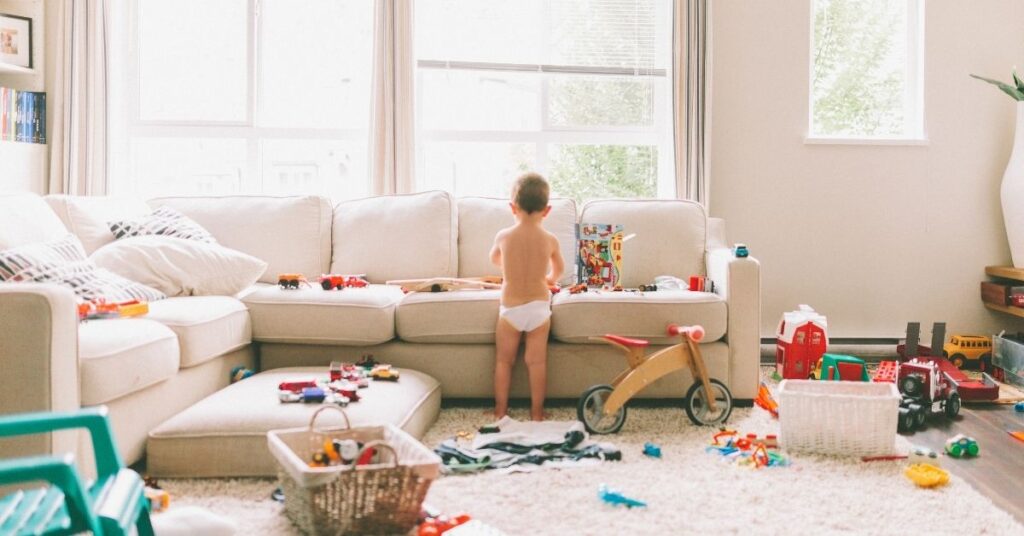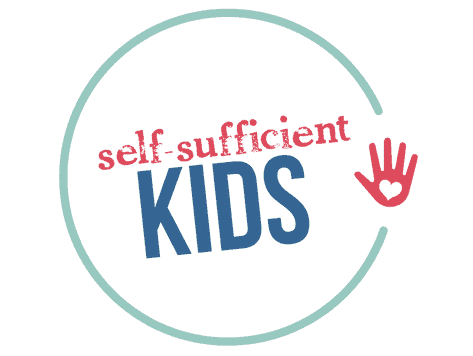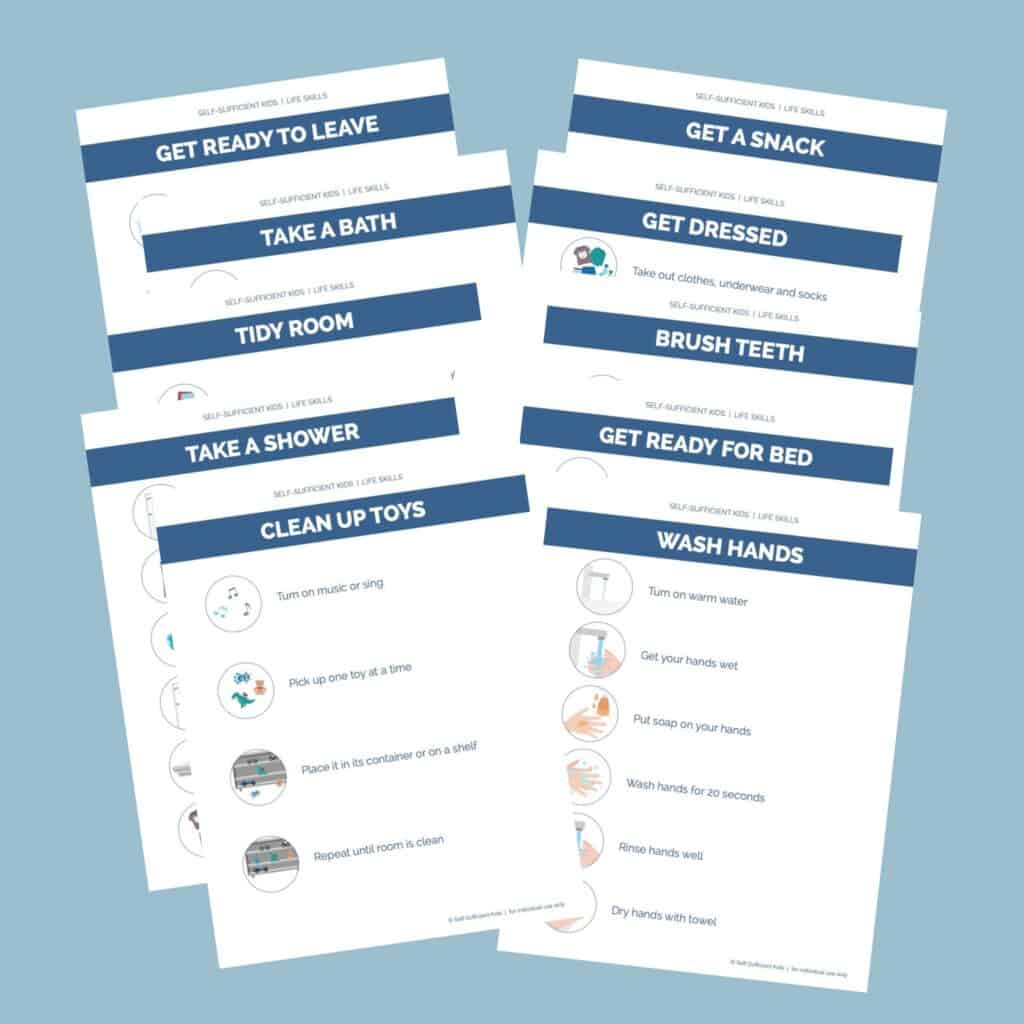How to Encourage Imaginary Play (and Why it’s so Important)
Inside: Imaginary play (also known as pretend play) helps kids’ cognition, emotions, and promotes problem-solving and creativity. Here are five ideas to help encourage your child’s imaginary play.

“We’re playing Abby’s birthday,” my six-year-old daughter told me.
“These are her presents!” my three-year-old son chimed in. He pointed to a pile of toys – all of which they’d dumped from their closet and bins.
When I first walked upstairs to check on my two kids after quiet time, the first thing I noticed was the mess. They had scattered all their toy houses around the room. They had pulled out every single doll and Barbie they owned. They had placed figurines on each floor of each toy house. They’d even used their Magna-Tiles to create a garage.
This mess? It was actually imaginary play like I had never seen them engage in before. They had created an entire town using their imagination and toys. Once I looked past the mess, I realized what they had created – and I was in awe.
“So you’re telling a story with your dolls?” I asked, barely unable to contain my excitement.
My daughter rolled her eyes. “No, Mom. We’re just playing!”
And that they were. They may not have called it “a whole new world,” but that is what it was. Their creativity had flourished with a bit of time and space to just be. It was a reminder to me that quiet time – and a chance for imaginary play – could do wonders for their creativity.
Why Imaginary Play is So Important For Young Kids
While imaginary play encourages creativity and imagination, it does a whole lot more than that.
According to Psychology Today:
“Systematic research has increasingly demonstrated a series of clear benefits of children’s engagement in pretend games from the ages of about two and one half through ages six or seven. Actual studies have demonstrated cognitive benefits such as increases in language usage including subjunctives, future tenses, and adjectives.”
Free time to play also gives kids a chance to problem solve, work through real-world issues, and process big feelings. They can take on a character’s (or toy’s) point of view, and through play learn about their place in the world. In many ways, it’s a lot like role playing.
When that pretend play involves other children – whether they’re friends, siblings, or other relatives – it also gives them a chance to practice their social and communication skills. After all, they’re having conversations with one another, even if it’s between dolls.
They can also learn to collaborate and, in turn, cooperate. I’ve lost count of the amount of times I’ve heard my kids negotiate over what toys (and characters) they’ll be in charge of, and what exactly they’ll be playing, whether it’s “birthday,” “moving day,” or “ballet,” some of the top themes in our house during play time. Do they always get along and share their toys? Heck no. But they’re learning…and they’re learning through play.
When my daughter first started going to school when she was three, she often used her “free play” time to mimic school. She decided all the bigger dolls were teachers, while the smaller stuffed animals and figurines were the students. My oldest took attendance and acted as the teacher, telling the “kids” what they would learn that day. More often than not, it included storytime. It was adorable, but even more importantly, it was her playing out her daily life so she could better understand it.
Help guide your young child through everyday tasks with these Simple Directions for Young Children Cards. Each card serves as a reminder of how to carry out a task and allows children to eventually take on tasks independently. Click here to learn more.
How To Get Started With Pretend Play
The way a child plays changes as they develop. As babies, they observe and learn how to grab things of interest. As young kids start to toddle, they mimic a lot of what their parents do – like talk on the phone or rocking a baby – and start to discover the wonder of independent play. Around age two, parallel play is common, which means kids typically play side by side rather than together. At age three and up, kids will often start to play together. Through all of these stages, playtime often includes a version of pretend play.
After all, pretend play can take all sorts of forms, from whipping up meals in their toy kitchen to dressing up as their favorite superheroes.
So, what’s one of the best things we can do as parents to encourage imaginary play? Play right along with them or join them in their created world or story.
Allow Them Take the Lead
When my oldest was around three years old, she used to take my “order,” scribble on a piece of paper, and then go gather empty toy plates and tea cups from her play kitchen. In this particular instance, she took the lead role. By allowing our kids to lead or guide pretend play time, we can pay attention to their interests and encourage their imagination.
See related: Why Kids Need Risky Play to Thrive
Demonstrate
Especially with younger kids, sit down on the floor and offer a few toys. Make a stuffed animal “talk” – I’ll never forget how that made my youngest giggle for the first time – and demonstrate how they can play out scenes with stuffed animals. As with so much of parenting, kids will often follow a parent’s lead.
Offer a Problem or Challenge
Alternatively, make up a problem for your kids to fix. For example, pretend a Paw Patrol vehicle is broke down, then allow their imaginations to run wild as your kiddo decides how to “fix” it.
The bonus with all of these strategies: you’re also building a bond with your children through play.
Other Ways to Encourage Pretend Play
One of the most beautiful things about imaginary play is that it doesn’t require a lot of expensive toys. The things that foster imaginary play the most are simply having space and encouragement to play. That said, I’ve noticed a few things that encourage my kids’ imaginations and the way they play.
Books, books, and more books
When kids are exposed to a variety of stories, whether fiction or nonfiction, their world is opened. They see potential, and story ideas, everywhere. Now that we’re a homeschooling family, we often bring out the clay as part of our lessons, and my kids love to create little figurines of their own based on the characters or animals we’ve read about.
Watching Other Kids Play With Toys
This may not be a popular opinion, but because kids also learn about play by watching other children play, I allow my kids to watch YouTube videos that feature kids playing with toys.
At first, it seemed like an odd thing for my kids to watch. Why not just play with their own toys rather than watch other kids play with theirs? But I’ve seen them watch videos – such as one about kids having their dolls visit the dentist – and then go re-enact those same scenarios in their own way.
The way I look at it: kids watching other kids play with toys is like me tuning into HGTV to watch the latest house remodel. While it may be screentime, both shows give us ideas for our own “play time” and encourage us to try new things.
Art supplies
While organized crafts are super fun, you don’t need to be a Pinterest parent to encourage your kid’s creativity. Simply having access to art supplies can give kids a chance to explore and create. Some of those supplies can include:
- Construction paper
- Markers
- Colored pencils
- Crayons
- Popsicle sticks
- Kid scissors
- Glue sticks
- Feathers
- Pipe cleaners
- Coloring pages
- Cardboard tubes
- Watercolor paints and brushes
We keep an art craft cart that is always stocked with art supplies. Whenever inspiration strikes them, they pull out a few supplies and start to create. This is how they’ve made books for their dolls, “musical instruments” out of cardboard tubes, and simply had fun with a random assortment of supplies.
Cardboard boxes
From the moment my kiddos have crawled, they have loved cardboard boxes. After all, cardboard boxes can be just about anything.
Hop aboard and fly to a distant island. Take a ship on the rough waters to fight off pirates. Build a train by connecting multiple boxes. Get in the car and go on some errands. Seriously, my kids have even playacted going to the grocery store.
It’s pretty amazing the things kids can come up with when they just have a cardboard box!
See related: How to Raise a Creative Kids (Even if You’re a Not-So-Creative Adult)
Let them be “bored”
Other than showing our kids examples of imaginary play when they’re young, pretend play shouldn’t be “work.” In fact, it doesn’t require much planning, if at all, and in our crazy, busy lives, that’s a bit of a relief!
Learning how to cope with boredom is a life skill, and that’s why giving our kids the gift of “boredom” is so important.
If the last few months have taught me anything, it’s this: sometimes my kids amaze me with the things they come up with when they just have the space to explore, play, and just be. They could have a room full of toys, but go on a whirlwind adventure with some sticks in the backyard.
In the world of pretend play, anything is possible – and that truly is a beautiful thing.
See related:
Why Kids Need Time for Independent Play (and How to Make it Happen)
How Quiet Time Can Fuel Your Child’s Creativity (And Help Your Sanity)
6 Ways Kids Routines Encourage Independence and Bring More Sanity to Your Life
“I can do it myself!” – How to Parent and Survive the Independent Toddler Stage
7 Tips to Help You Get Started With Toddler Chores Successfully
What to do next…
1. Subscribe to Self-Sufficient Kids’ email list.
Like what you read here and want to learn more? Every Thursday I’ll send you one parenting tip about raising self-sufficient kids and creating the peaceful relationship you yearn to have with your child. Click here to sign up.
2. Take one of my quizzes!
Find out if you’re raising a self-sufficient kid (click here) or if you’re doing too much for your kids (click here). At the end of each quiz, you’ll be asked to provide your email address to see the results.
3. Get your kids started on chores.
Learn how to get your child started on chores (& keep them motivated + avoid power struggles) by enrolling in my Get Your Kids Successfully Started on Chores course. Click here to learn more and sign up.

Liz SanFilippo Hall is a work-at-home mama who runs on caffeine and Reese’s peanut butter cups. While her two kids sleep (or, when she steals a minute or two for herself), she blogs about parenting and the work-at-home life on Oops and Daises, writes her soon-to-be children’s books, and helps other mamas feel beautiful and confident through her online makeup and skincare business.


